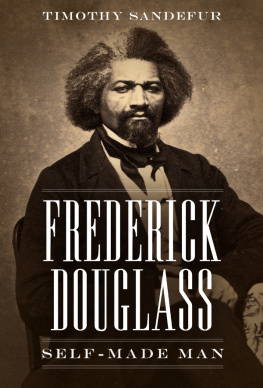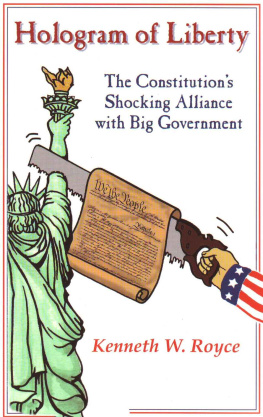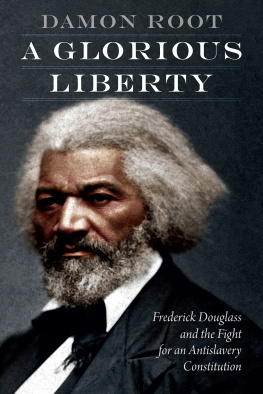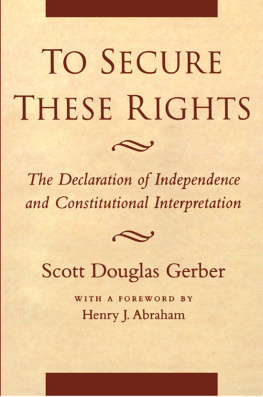
Copyright 2014 by Cato Institute.
All rights reserved.
Library of Congress Cataloging-in-Publication Data
Sandefur, Timothy.
The conscience of the Constitution: the Declaration of Independence and the
right to liberty / Timothy Sandefur.
pages cm
Includes bibliographical references.
ISBN 1-939709-03-2 (hardback : alk. paper)
1. Civil rights--United States. 2. Due process of law--United States.
3. Political questions and judicial power--United States. 4. Liberty--Philosophy. I. Title.
KF4749.S26 2014
342.73085--dc23
2013032221
Cover design by Jon Meyers.
Printed in the United States of America.
CATO INSTITUTE
1000 Massachusetts Ave., N.W.
Washington, D.C. 20001
www.cato.org
Dedication
To Christina
Contents
My thanks to Roger Pilon, Deborah J. La Fetra, and Christina Sandefur, who offered many detailed and thought-provoking suggestions on the manuscript. Portions of these chapters are based on material that appeared in Cato Unbound; the Chapman Law Review; the Harvard Journal of Law and Public Policy; the Journal of Law & Politics; the New York University Journal of Law & Liberty; the Notre Dame Journal of Law, Ethics, & Public Policy; and Reason Papers, and are used with permission. My thanks also to Samantha Dravis, Daniel A. Himebaugh, David B. Kopel, Trevor Burrus, Jason Kuznicki, Tibor R. Machan, R. S. Radford, and Ilya Shapiro. This book is partly the result of more than a decade of work with the Pacific Legal Foundation, for which I am immensely grateful. But the opinions expressed herein are not necessarily those of the foundation, its staff, supporters, or clients.
American constitutional history has always hovered in the mutual resistance of two principles: the right of each individual to be free, and the power of the majority to make rules. The dynamic tension of these two ideas has generated some of our most persistent and complicated debates. Yet they are not just forces moving in opposite directions. Rightly understood, liberty and order are profoundly interrelated: without order, liberty is not actually liberty, but a chaos in which every person is vulnerable to being violated and controlled by others: For who could be free, asked John Locke, when every other Mans Humour might domineer over him? On the other hand, order without liberty is not really order at all; it is a terrifying void in which the will of the ruler becomes the ultimate reality, and the citizen must stand constantly on guard for shifts in the rulers mood. When the relationship between liberty and order is perverted, the entire political system can be thrown out of sync, resulting in abuses of power that undermine the legitimacy of government itself. In 1864, Abraham Lincoln articulated this point with a typically well-chosen metaphor:
We all declare for liberty; but in using the same word we do not all mean the same thing. With some the word liberty may mean for each man to do as he pleases with himself, and the product of his labor; while with others the same word may mean for some men to do as they please with other men, and the product of other mens labor. Here are two, not only different, but incompatible things, called by the same nameliberty.... The shepherd drives the wolf from the sheeps throat, for which the sheep thanks the shepherd as a liberator, while the wolf denounces him for the same act as the destroyer of liberty.... Plainly the sheep and the wolf are not agreed upon a definition of the word liberty.
Lincoln understood that while the power to make rules is important, it is not the most basic principle of our constitutional system. The wolf is wrong to imagine that he has a fundamental right to rule others, or that the sheeps rights are simply whatever the wolf decides to allow. Americas constitutional order is premised on the opposite principle: on the basic right of each person to be free. People are born with liberty; their rights are not privileges that government gives to them as it pleases. Legitimate government is based on, and bound by, their rights, and nobodyno king, no legislature, no democratic majorityhas any basic entitlement to control them. Freedom is the starting point of politics; governments powers are secondary and derivative, and therefore limited.
That principlethe primacy of libertywas most eloquently expressed in the Declaration of Independence. That document, which created the United States as a political unit and defines the terms of its sovereignty, is the light by which we must guide our understanding of our political and legal institutions. More than a merely rhetorical statement, the Declaration sets the framework for reading our fundamental law. It is, in short, the conscience of the Constitution. Together, the Declaration and the Constitution hold that all people are naturally born free, and may use their freedom to create a political and legal order that respects and protects their rights. But because government can be perverted and endanger liberty, the people must take care to design it in such a way that it is both strong enough to secure their freedom, and limited so as not to threaten that freedom. Liberty is the goal at which democracy aims, not the other way around.
Nevertheless, people often misconstrue the relationship between liberty and order, attempting to elevate democratic power above the individual rights it is supposed to protect, or to assert that the majority has some fundamental right to rule. The most obvious example of this perverse understanding of political order is slavery. Nineteenth-century defenders of slavery and states rights rejected the Declarations principles, and advocated instead what Lincoln called the wolfs notion that political power is primary, and freedom only a secondary privilege conferred by society. It is a great and dangerous error to suppose that all people are equally entitled to liberty, wrote the champion of this States Rights school, John C. Calhoun. Freedom, he said, is a reward to be earned, not a blessing to be gratuitously lavished on all alikea reward reserved for the intelligent, the patriotic, the virtuous and deserving.
The collision of this wolfish doctrine with the nations founding principles of equality and liberty put America on the path to civil war; the nation could not permanently endure while divided over such a basic matter. In the years leading up to that war, anti-slavery leaders who remained faithful to the Declarations principles developed a constitutional interpretation that would counter that argument and give real effect to the primacy of liberty. These menincluding Congressman and former president John Quincy Adams, Senator Charles Sumner, Representative John Bingham, future chief justice Salmon P. Chase, and former slave Frederick Douglasslaid the groundwork for the great constitutional revolution that the war ushered in. When peace came, they sought to ensure that the primacy of liberty would be permanently enshrined in the nations fundamental law. They drafted the Fourteenth Amendment to rededicate the nation to the ideas of the Declaration.
But new challenges soon arosefirst with the Supreme Courts shocking refusal to enforce one of the central guarantees of that amendment, and then, in the 20th century, when new political theories emerged that once again upended the relationship of liberty to order. Led by Progressive Erathinkers such as Oliver Wendell Holmes, John Dewey, and Louis Brandeis, that effort was so successful that today the leaders of political and legal opinion generally hold that order comes before liberty, and that democratic rule is the basic premise of our institutions, with individual freedoms regarded essentially as privileges given to people by government. Todays debates over the perceived danger of judicial activism, or over legal theories like substantive due process, often take for granted this modern wolfs conception of the relationship of liberty to order.
Next page







